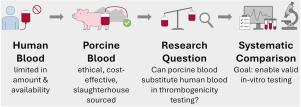The porcine abattoir blood model — Bridging the gap between human and porcine blood for in-vitro testing
IF 9.6
1区 医学
Q1 ENGINEERING, BIOMEDICAL
引用次数: 0
Abstract
Background:
Reliable in-vitro thrombogenicity testing of medical devices requires large blood volumes, which cannot be obtained from humans. Slaughterhouse blood is an ethically acceptable, cost-effective alternative. While porcine blood is already used in hemolysis testing, its use for thrombogenicity testing remains limited regarding its comparability to human blood.
Objectives:
This study systematically characterizes porcine slaughterhouse in comparison to human blood regarding key parameters relevant for thrombogenicity testing. The goal is to evaluate its suitability for standardized in-vitro tests.
Methods:
Human donor and porcine slaughterhouse blood were analyzed for key thrombogenicity parameters. These included coagulation markers (ROTEM parameters, TAT, fibrinogen), platelet and complement activation (PLAs, P-selectin, C3a, SC5b9), and stress-related hormones (adrenaline, cortisol). The influence of two different anticoagulants (enoxaparin and citrate) was also assessed.
Results:
Despite moderate pre-activation in pig blood – especially for platelets, complement and stress markers – intact reaction patterns were observed. Exemplarily, ROTEM analysis revealed species-specific characteristics such as reduced clotting time (CT) and increased clot strength (A30) in pigs, while overall reactivity was preserved. In addition, porcine platelets maintained their responsiveness to agonists, suggesting that further activation is possible despite the increased baseline. Importantly, the effect of anticoagulants (citrate vs. enoxaparin) was the same in both species, suggesting that the methodological scope used in in-vitro assays is transferable.
Conclusions:
These results emphasize that, when properly collected and handled, slaughterhouse porcine blood can be a viable and reliable alternative to human blood for thrombogenicity testing, although certain baseline differences must be taken into account.
Statement of significance:
Reliable in-vitro testing of the thrombogenicity of medical devices is crucial for their safety, but requires large volumes of blood that often cannot be covered by conventional human blood donations. This study provides for the first time a comprehensive characterization of pig slaughterhouse blood compared to human blood with regard to hematological, inflammatory and coagulation-related parameters. The results show which properties are comparable and which differences need to be taken into account. The work thus lays the foundation for the establishment of an ethically justifiable and practical thrombogenicity model — an important step towards animal-free thrombogenicity tests in the development of blood-contacting medical products.

猪屠宰场血液模型-弥合人血和猪血之间的差距,用于体外测试。
背景:可靠的医疗器械体外血栓形成试验需要大量的血容量,这是无法从人体内获得的。屠宰场的血液是一种道德上可接受的、具有成本效益的替代品。虽然猪血已用于溶血试验,但由于其与人血的可比性,其用于血栓性试验的用途仍然有限。目的:本研究系统地比较了猪屠宰场与人血液中与血栓形成试验相关的关键参数。目的是评估其在标准化体外测试中的适用性。方法:分析人血和猪屠宰场血的主要凝血指标。这些指标包括凝血标志物(ROTEM参数、TAT、纤维蛋白原)、血小板和补体活化(pla、p -选择素、C3a、SC5b9)以及应激相关激素(肾上腺素、皮质醇)。还评估了两种不同抗凝剂(依诺肝素和柠檬酸盐)的影响。结果:尽管在猪血液中有适度的预激活,特别是对血小板、补体和应激标记物,但观察到完整的反应模式。例如,ROTEM分析揭示了猪的物种特异性特征,如凝血时间缩短(CT)和凝血强度增加(A30),同时保持了总体反应性。此外,猪血小板保持了对激动剂的反应性,这表明尽管基线升高,但进一步激活是可能的。重要的是,抗凝血剂(柠檬酸盐与依诺肝素)的作用在两个物种中是相同的,这表明体外测定中使用的方法范围是可转移的。结论:这些结果强调,如果收集和处理得当,屠宰场的猪血可以替代人血进行血栓性检测,尽管必须考虑到某些基线差异。重要性说明:医疗器械血栓形成性的可靠体外测试对其安全性至关重要,但需要大量的血液,而传统的人类献血往往无法覆盖这些血液。这项研究首次提供了猪屠宰场血液与人类血液在血液学、炎症和凝血相关参数方面的综合特征。结果显示哪些属性是可比较的,哪些差异需要考虑。因此,这项工作为建立道德上合理和实用的凝血性模型奠定了基础,这是在开发血液接触医疗产品时迈向无动物凝血性测试的重要一步。
本文章由计算机程序翻译,如有差异,请以英文原文为准。
求助全文
约1分钟内获得全文
求助全文
来源期刊

Acta Biomaterialia
工程技术-材料科学:生物材料
CiteScore
16.80
自引率
3.10%
发文量
776
审稿时长
30 days
期刊介绍:
Acta Biomaterialia is a monthly peer-reviewed scientific journal published by Elsevier. The journal was established in January 2005. The editor-in-chief is W.R. Wagner (University of Pittsburgh). The journal covers research in biomaterials science, including the interrelationship of biomaterial structure and function from macroscale to nanoscale. Topical coverage includes biomedical and biocompatible materials.
 求助内容:
求助内容: 应助结果提醒方式:
应助结果提醒方式:


